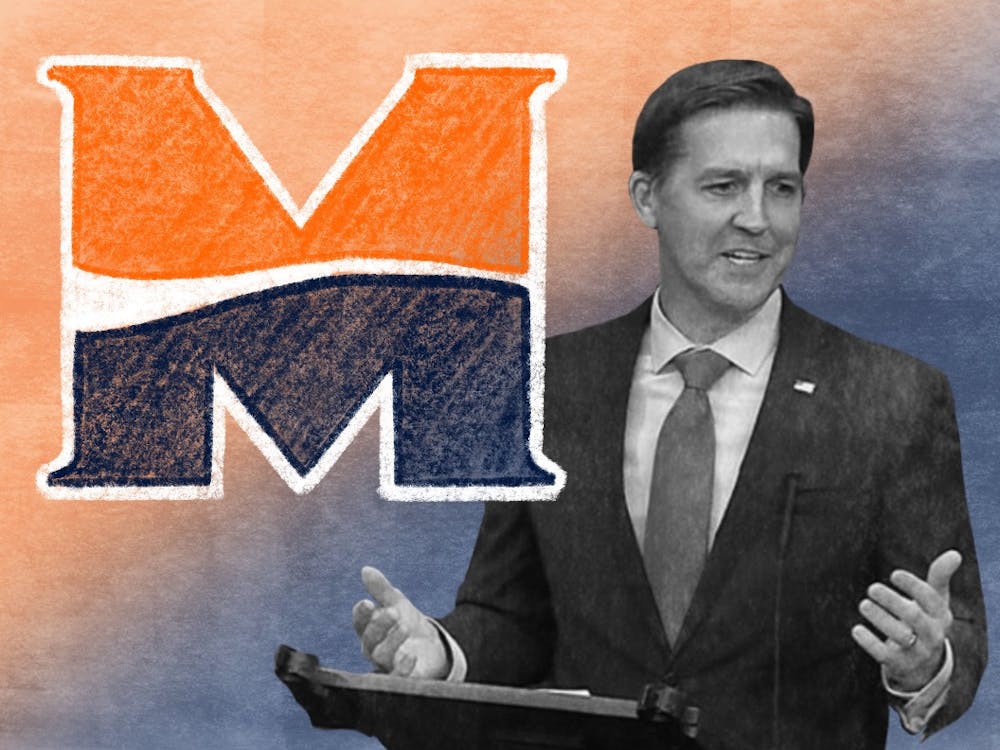An untransparent search process, elimination of tenure and pressure to take a retirement buyout — Ben Sasse’s presidency didn’t please everyone at Midland University.
One policy under Sasse’s administration stands out to two professors: a loyalty oath faculty were allegedly forced to sign. This oath promised they wouldn’t speak negatively of the university or of Sasse.
Now, these two individuals, who were Midland faculty members at the time of Sasse’s presidency, spoke to The Alligator under the condition of anonymity for fear of retaliation. They said the oath, along with a long line of other policies, define what some at Midland call a toxic workplace under Sasse.
One professor shared their notes from the time with The Alligator, which document faculty needing to sign by Oct. 12, 2012 — around two years after Sasse became Midland president. The professor referred to it as “the blood oath” faculty had to sign in order to keep working at Midland.
Looking back at Sasse’s presidency, some at Midland felt the bottom line was profit — not faculty well-being. Midland faculty recall periods of buyouts and a shake-up of leadership as Sasse cleared out long-time professors. His later run for office also didn’t come as a surprise to some.
Midland University communications didn’t respond to multiple phone calls and emails. UF was also unable to comment in time for publication.
Fremont native’s path to Midland University
Located 25 miles west of Omaha, the city of Fremont, Nebraska, has a total population that’s smaller than UF’s undergraduate enrollment. Although its downtown is listed in the National Register of Historic Places, the town’s hog processing plan and $450 million Costco chicken plant — built in the last few years — are indicative of Fremont’s ability for growth.
The enrollment at Midland is now 1,600 students — an-all time high — and significant to the town’s economy. Midland graduates often settle in Fremont, working in the hospital and local banks. It’s a place Fremont Mayor Joey Spellerberg holds dear.
“Midland University has always been a very core part of Fremont,” Spellerberg said.
Midland’s success in Fremont hadn’t always been a guarantee. There was a time when the college was faced with possibly closing its doors for good as it stared down bankruptcy.
Fremont and Midland have been a core part of Sasse’s identity in his journey to become a U.S. senator.
Sasse is a Fremont native, and was the valedictorian of his graduating class at Fremont High School. His father was a Midland alumnus and his grandfather was involved at the college for 33 years, including a time as the vice president of finance.
In the five years before Sasse arrived, freshmen enrollment at Midland dropped by 60%. In February 2010, the school was worried it wouldn’t make payroll, according to reporting by The Omaha World-Herald.
Midland had gone through a series of interim presidents since 2007, when president Steve Titus resigned in the face of a faculty vote of no confidence.
Sasse was initially contacted by the Midland Board of Trustees as an informal advisor while the college was in dire straits, according to reporting by the Fremont Tribune. Conversations began to soon revolve around Sasse taking a larger role, and he was soon selected to become the president.
"It really was an accelerated process," Board of Trustees President Steve Bullock told the Tribune. "Since the early part of the fall, we moved very quickly."
Alcyone Scott, who at the time was an English professor and the faculty chair, described Sasse’s hiring process to Mother Jones in 2016 as predetermined.
“[Bullock] called a meeting of the faculty and staff,” Scott said. “The option was the college would close, or we would go along with the plan of some of the city fathers to hire this guy who actually grew up in Fremont to come in and turn the college around.”
Bill Staley, Midland’s chair of sociology at the time, said from his perspective, it wasn’t a search.
“We didn't go through a system of elimination and interviews and all that type of stuff,” Staley told The Alligator. “We were basically asked to waive all the protocol and all the procedures and just go with it.”
Sasse’s path to power at Midland and UF were similar. The search for the new president that led to Titus came down to three final candidates.
Faculty was essentially given two options: the end of Midland or taking a chance on Sasse, Scott said.
“When they brought him on, I thought he was a pretty classy guy,” Staley said. “But I wasn't very pleased with some of the other presidents we had gone through.”
Name change, faculty buyouts mark Sasse’s first year as Midland president
Sasse’s first orders of business were simple, yet transformative.
He changed its name, from Midland Lutheran College to Midland University, in order to attract more students. The school’s colors also went from orange and black to orange and navy blue, according to the Fremont Tribune.
Sasse approached his role with a business mindset. Before becoming Midland president, he worked as a consultant for Boston Consulting Group and McKinsey and Company. He referred to students as “customers” and faculty as “employees.”
Leading the college came with more difficult business decisions beyond a quick name and color change.
When Sasse arrived in May 2010, he gathered the school’s longest tenured faculty and announced that many of them would be offered an early-retirement buyout or asked to restructure their contracts, as reported by the Omaha World-Herald.
The only way Midland could get rid of long established professors like Staley or his friend Scott was a buyout, Staley said, because they had tenure. Once tenured faculty were gone, they were replaced with untenured, adjunct faculty.
Staley thought at least part of the reason Sasse put some pressure on senior faculty to go was because of his ambition to abolish tenure, he said. Staley was recovering from a heart surgery at the time and ready for retirement, so he took a buyout in 2011, but only on a few conditions after he saw the initial contract.
“I said, ‘Whoever wrote this was a pretty shady lawyer,’” Staley said. “‘You want me to sign this? If you want me to sign an agreement, let’s rewrite this thing. This is pathetic, and you’ve been giving this to other faculty?’”
Staley, a former county judge, said the language in the initial contract was unprofessional. He met with Sasse personally in Omaha and the two rewrote the buyout agreement over lunch.
Not all retired faculty felt the same way about Sasse’s buyout program. Greg Clements taught physics and astronomy at Midland for 32 years before his retirement in 2015. When asked if faculty felt forced into retirement, Clements pointed out it was the professors’ ultimate decision.
“There was a little bit of that sentiment,” Clements said. “But ‘force’ may be a little too strong of a term.”
Joanne Bracker coached Midland University’s women’s basketball team for 42 years until her retirement in 2012. In 1999, she was inducted among the first class of the Women’s Basketball Hall of Fame. Bracker was also an academic advisor and a faculty member at Midland when Sasse was president.
An anonymous professor who worked atMidland during Sasse’s presidency said faculty members over the age of 55 were pressured by the administration to retire early. While she wasn't positive of the age line, she agreed there was pressure to accept the buyouts, Bracker said.
“In a short period of time, a matter of hours, make a decision,” Bracker said she was told. “Do you want to be a head coach? Do you want to be a tenured faculty? You can’t do both. There are your options, there’s no discussion.”
Sasse was up-front with them: They could take the buyout or continue at the university with an uncertain future after he got rid of tenure.
Bracker remembers groups of five or six faculty members at a time would lose their tenure, she said. She was one of the last to finally lose it.
“You can usurp power, and then you can do certain things because you usurp power,” Scott told Mother Jones. “But there might have been a kinder, gentler way to do that than to say, ‘These are the new rules; this is what we’re gonna do.'”
Longtime, established faculty members who took the buyouts were replaced with low-cost, part-time adjunct professors in a cost-saving move, some former faculty members said.
While the move was touted as a way to make Midland more financially solvent, Staley wasn’t so sure.
“It felt like they could get rid of tenure to get rid of people they felt they were paying too much,” Staley said. “I always looked at it as more of a power issue.”
A professor who was at Midland at the time described it as a decapitation of the leadership of the university, a sentiment Bracker also agreed with.
“Faculty invested their lives in that program — in that school,” Bracker said. “There were a lot of really depressed faculty who felt they hadn’t been treated fairly.”
Jim Tremain, a retired psychology professor and faculty chair who began at Midland in 1973, credited Sasse’s ability to get the banks to forgive Midland’s loans, but said the longer-serving faculty with a vested interest in the institution felt neglected.
“Obviously, the faculty felt we were becoming more and more diminished in whatever we had to say about the future of the college,” Tremain said.
Academic requirements were downsized while Midland began to offer more unique extracurriculars in order to bring in more students, Bracker said. Midland, which competes in the National Association of Intercollegiate Athletics, also added many more varsity sports programs, which she said were used to boost recruitment and enrollment.
Midland’s sudden enrollment boost
That summer, Midland received an injection of life. Dana College, located just a half-hour northeast of campus down U.S. Highway 30, suddenly closed its doors.
Staley took part in a study five years beforehand that analyzed Midland and Dana — two schools with similar student populations and organization, he said. It concluded that within three to five years, one of the schools would shut down. Dana found itself on the losing end of that coin toss.
“In modern times, you need about 1,500 students in order to be financially viable and secure,” Staley said. “I would attribute Midland’s turn around, if you want to call it that, to Dana closing more than anything else.”
Sasse oversaw the Dana@Midland initiative, which offered former Dana students free room and board and matching financial aid if they chose to transfer to Midland.
Three hundred and twenty-one former Dana students came to Midland, as reported by the Fremont Tribune — a much needed boost to the university’s enrollment, bringing it to nearly 1,000. By the time Sasse began his campaign for the U.S. Senate in 2013, Midland had 1,100 students.
David Mitchell, a partner at Fremont’s Yost Law Firm and an adjunct business law instructor at Midland for 20 years, credited Sasse with shepherding the process.
“[Sasse] led immediate efforts to salvage those academic relationships with Dana, to bring those kids over in a very seamless and easy fashion,” Mitchell said.
Sasse handled Midland’s turnaround the way any good businessman would, he added.
“Ben did a fantastic job taking a university that was struggling financially, as well as with low enrollment, and coming in and retooling it, re-imaging it and helping change the overall curriculum,” Mitchell said.
Sasse hire resigns, arrested, pleads guilty
In August 2011, Sasse hired Jason Dannelly to become Midland’s athletic director. Dannelly had founded the Victory Sports Network, which covered NAIA sports.
"Nobody knows NAIA athletics like Jason and we are very lucky to have him join our leadership team," Sasse said, according to the Tribune. "I know he will do an outstanding job for our players and coaches and he will play a key role in delivering a richer experience for our fans."
By November 2012, however, Dannelly was gone — the university announced he had resigned due to personal reasons. Those reasons became clear less than eight months later, when Dannelly was arrested by the Fremont Police Department.
Detective Joyce Henke had filed an affidavit in Dodge County Court that Dannelly, while at Midland, offered a 20-year-old female student athlete $300 to have sex with him.
Another student athlete approached Dannelly asking for help navigating through minor legal trouble. Dannelly said he would help her if she had sex with him and warned her if she told anybody, she would be found floating in the Loup River, according to the Fremont Tribune.
The Midland student was 18 years old.
That threat came less than a year after former Midland University football player Joshua Keadle murdered a student from Peru State College and disposed of her body in the Missouri River.
Dannelly was able to plead no-contest to charges of solicitation, pandering and terroristic threats in 2014, according to files obtained by The Alligator. He was sentenced to one year of probation.
The Alligator was unable to reach Dannelly for comment. His defense attorney, Clarence Mock, didn’t return The Alligator’s request for comment.
The Alligator was unable to find any public comment by Sasse on Dannelly’s charges.
Sasse’s strained relationship with faculty, staff
Sasse’s corporate-like strategy had an effect: In 2012, the Fremont Area Chamber of Commerce named Midland University its business of the year.
Despite the success, some at Midland felt Sasse’s personality came at odds with theirs.
“Sasse is a brilliant man — very well educated,” Bracker said. “I guess my biggest concern was I really opposed boastful arrogance. I always felt he was very boastful and almost belittling you about his knowledge or intelligence.”
Sasse didn’t let anybody forget his Ivy League academic credentials, Bracker said.
“I think he's smart, I don't think he's brilliant,” Staley said. “I have a PhD and a law degree and I know a lot of people with PhDs and law degrees that are dumb as a brick. So, I don't think that's the measure.”
Bracker’s opinion of Sasse changed as his presidency progressed, she said, and she lost a lot of respect for him for the way he handled the faculty when he abolished tenure.
“I just don't think [the faculty] were given accountability or given credit for what they contributed to the college, or what their role was at the college, or their dedication,” Bracker said.
Former Midland faculty, however, said the school’s undeniable financial turnaround came at a cost.
Robert Therien, a Midland art professor for 38 years before he left in 2011, was blunt to Mother Jones.
“I think Ben Sasse just pretty much destroyed that school,” Therien said.
Therien declined to comment further when contacted by The Alligator.
Bracker characterized Sasse’s relationship with faculty as somewhat strained. To her, the school’s expanded emphasis on extracurricular activities and athletic recruiting shifted the student environment away from its blue-collar, Nebraskan base.
“I think the academic requirements — the liberal arts requirements — were downsized considerably,” Bracker said. “[Sasse] surrounds himself with good consultants, but he's definitely made some unfortunate decisions.”
In Staley’s view, it was indicative that small colleges aren’t interested in education for the sake of itself anymore, he said.
“It's all about getting a good housekeeping seal of approval stamped on your ass so you can sell yourself in a capitalist marketplace,” Staley said.
Jumpstart to political career
Midland wasn’t just a passion project for Sasse, Bracker said, but an avenue to further his political career — an item for the man who always had a plan.
“I just felt he put himself above the faculty and he was pretty much out for himself,” Bracker said.
Staley and some other faculty members believed Sasse’s reason for taking the job as Fremont’s president was to reingratiate himself with the state of Nebraska before an eventual run for the U.S. Senate, he said.
A professor who was at Midland while Sasse was there said it was common knowledge among the faculty that Sasse was using Midland as a vault to political office.
Some former Midland administrators followed Sasse to the Capitol as well.
Shelly Blake was Midland’s director of special projects from 2010 to 2014, before she followed Sasse to become his state deputy chief of staff.
Kari Ridder spent nine years as the Fremont United Way executive director before she joined Midland as the vice president of development from 2010 to 2015. She later joined Sasse’s Senate staff as the state policy director.
Raymond Sass was an advisor to Sasse while he was president of Midland. Sass would later officially come aboard as the founding director of the MBA program and eventual vice president of strategy. In 2017, he left Midland to become Sasse’s chief of staff.
Throughout The Alligator’s reporting, several sources said, unprompted, they felt Sasse ultimately had ambitions for the White House. In Staley’s opinion, Sasse has been running for president since high school.
“If I saw any sign that Ben was motivated to use [UF] as a stepping stone for higher accomplishments, I'd be opposed to him as well,” Staley said, on UF student protests that occured in the wake of UF’s announcement of Sasse as presidential sole finalist. “As much as I liked the guy, I don't trust him.”
Contact Christian at ccasale@alligator.org. Follow him on Twitter @vanityhack.

Christian Casale is a history senior and the university desk editor for The Alligator. In his spare time, he loves writing his bio for the website and watching movies alone in the dark.






